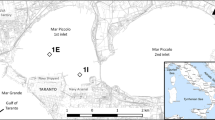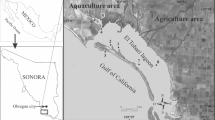Abstract
The Bremerhaven Caisson, a benthic mesocosm enclosing a 13 m2 sediment area and 13 m3 trapped water column at high tide, was used for field experiments on the fate of lead and chromium at the isle of Norderney, Southern German Bight. The caisson, made from seawater resistant aluminium, settled on fine sand (mean grain size: 0.2 mm) at an experimental site with about 0.9-m tidal height and 4.5 h of water coverage. During 38 consecutive tides a constant amount of lead was administered to the inflowing water, resulting in a nominal concentration of 0.1 mg l-1 at high tide. A second caisson was taken for chromium using the same procedure. The compartments analysed (water, seston, sediment, and infauna) showed distinct differences for lead and chromium. The particle-reactive element Pb adsorbed by 50–70% onto seston particles, the soluble element Cr-VI by less than 2%. Only a moderate enrichment was measured in the sediment, about 3–4% of the total Pb and Cr added accumulated in the top 3 cm. The fauna attained much higher accumulation factors than the sediment. The lead uptake rates of 15 species and 2 taxa can be placed in order according to the feeding type: filter feeder > deposit feeder (surface) > opportunistic feeder (deposit feeder or predator) > deposit feeder (depth). Chromium was accumulated about 10 times lower than lead, the uptake seems to be more related to the systematic position of the animal (calcareous shell versus chitinous cuticle). In the total mass balance only 0.2% of the lead added and 0.02% of the chromium added were fixed by the fauna.
Similar content being viewed by others
Literature cited
Amdurer, M., D. M. Adler and P. H. Santschi: Radiotracers in studies of trace metal behavior in mesocosms: advantages and limitations. In: Marine mesocosms, pp 81–95. Ed. by G. D. Grice and M. R. Reeve. New York-Heidelberg-Berlin: Springer Verlag 1982
Banse, K.: Experimental marine ecosystem enclosures in a historical perspective. In: Marine mesocosms, pp 10–24. Ed. by G. D. Grice and M. R. Reeve, New York-Heidelberg-Berlin: Springer Verlag 1982
Boyden, C. R.: Trace element content and body size in molluscs. Nature, Lond. 251, 311–314 (1974)
Boyden, C. R.: Distribution of some trace metals in Poole Harbour, Dorset. Mar. Pollut. Bull. 6, 180–187 (1975)
Boyden, C. R.: Effect of size upon metal content of shellfish. J. mar. biol. Ass. U. K. 57, 675–714 (1977)
Bryan, G. W.: Adaptation of an estuarine polychaete to sediments containing high concentrations of heavy metals. In: Pollution and physiology of marine organisms, pp 123–135. Ed. by F. J. Vernberg and W. B. Vernberg, New York: Academic Press 1974
Bryan, G. W. and L. G. Hummerstone: Adaptation of the polychaete Nereis diversicolor to estuarine sediments containing high concentrations of heavy metals. I. General observations and adaptation to copper. J. mar. biol. Ass. U.K. 51, 845–863 (1971)
Cooke, M., G. Nickless, R. E. Lawn and D. J. Roberts: Biological availability of sediment-bound cadmium to the edible cockle, Cerastoderma edule. Bull. environ. Contam. Toxicol. 23, 381–386 (1979)
Cranston, R. E. and J. W. Murray: The determination of chromium species in natural waters. Analyt. chim. Acta 99, 275–282 (1978)
Cunningham, P. A.: The use of bivalve molluscs in heavy metal pollution research. In: Marine pollution: functional responses, pp 183–221. Ed. by W. B. Vernberg, A. Calabrese, F. P. Thurberg and F. J. Vernberg. New York: Academic Press 1979
De Wilde, P. A. and B. R. Kuipers: A large indoor tidal mud-flat ecosystem. Helgoländer wiss. Meeresunters. 30, 334–342 (1977)
De Wolf, P., W. C. De Kock and A. Stam: Veldproeven over de invloed van koper en kwik op een natuurlijke mosselbank. TNO-nieuws 27, 497–504 (1972)
Duinker, J. C. and R. F. Nolting: Distribution model for particulate trace metals in the Rhine estuary, Southern Bight and Dutch Wadden Sea. Neth. J. Sea Res. 10, 71–102 (1976)
Eldon, J., M. Pekkarinen and R. Kristoffersson: Effects of low concentrations of heavy metals on the bivalve Macoma balthica. Ann. Zool. Fennici 17, 233–242 (1980)
Farke, H., M. Schulz-Bades and S. A. Gerlach: The Bremerhaven Caisson, a mesocosm for field studies of intertidal ecosystems. (In preparation)
Fernandez, F. J., M. M. Beaty and W. B. Barnett: Use of the L'Vov platform for furnace atomic absorption applications. At. Spectrosc. 2, 16–21 (1981)
Grice, G. D. and M. R. Reeve: Marine mesocosms, 430 pp. New York-Heidelberg-Berlin: Springer Verlag 1982
Haul, R. and G. Dümbgen: Vereinfachte Methode zur Messung von Oberflächengrößen durch Gasadsorption. Chem.-Ing. Techn. 35, 586–589 (1963)
Jackim, E., E. Morrison and R. Stede: Effects of environmental factors on radiocadmium uptake by four species of marine bivalves. Mar. Biol. 40, 303–308 (1977)
Kremling, K., J. Pinze, K. von Bröckel and C. S. Wong: Studies on the pathways and effects of cadmium in controlled ecosystem enclosures. Mar. Biol. 48, 1–10 (1978)
Luoma, S. N. and E. A. Jenne: The availability of sedimentbound cobalt, silver, and zinc to a deposit-feeding clam. In: Biological implications of metals in the environment, pp 213–230. Ed. by H. Drucker and R. E. Wildung. Springfield: Technical Information Center, Energy Research and Development Administration 1977
Newell, R. C.: Biology of intertidal animals, 3rd edition, 781 pp. Faversham, Kent: Marine Ecological Surveys Ltd 1979
Packer, D. M., M. P. Ireland and R. J. Wootton: Cadmium, copper, lead, zinc, and manganese in the polychaete Arenicola marina from sediments around the coast of Wales. Environ. Pollut. 22, 309–321 (1980)
Phelps, H. L.: Cadmium sorption in estuarine mud-type sediment and the accumulation of cadmium in the soft-shell clam, Mya arenaria. Estuaries 2, 40–44 (1979)
Phillips, D. J. H.: The use of biological indicator organisms to monitor trace metal pollution in marine and estuarine environments — a review. Environ. Pollut. 13, 281–317 (1977)
Phillips, D. J. H.: Quantitative aquatic biological indicators, 488 pp. London: Applied Science Publishers Ltd. 1980
Pilson, M. E. Q., C. A. Oviett, G. A. Vargo and S. L. Vargo: Replicability of MERL microcosms: initial observations. In: Advances in marine environmental research, pp 359–381. Ed. by F. S. Jakoff. Narragansett, R. I.: EPA-600/9-79-035, US Environmental Protection Agency 1979
Prentø, P.: Metals and phosphate in the chloragosomes of Lumbricus terrestris and their possible physiological significance. Cell Tissue Res. 196, 123–134 (1979)
Ray, S., D. W. McLeese and M. R. Peterson: Accumulation of copper, zinc, cadmium and lead from two contaminated sediments by three marine invertebrates — a laboratory study. Bull. environ. Contam. Toxicol. 26, 315–322 (1981)
Santschi, P. H., Y. H. Li and S. R. Carson: The fate of trace metals in Narragansett Bay, Rhode Island: radiotracer experiments in microcosms. Estuar. coast. mar. Sci. 10, 635–654 (1980)
Santschi, P. H.: Application of enclosures to the study of ocean chemistry. In: Marine mesocosms, pp 63–80. Ed. by G. D. Grice and M. R. Reeve. New York-Heidelberg-Berlin: Springer Verlag 1982
Schulz-Baldes, M.: Die Miesmuschel Mytilus edulis als Indikator für die Bleikonzentration im Weserästuar und in der Deutschen Bucht. Mar. Biol. 21, 98–102 (1973)
Schulz-Baldes, M.: Lead uptake from sea water and food, and lead loss in the common mussel Mytilus edulis. Mar. Biol. 25, 177–193 (1974)
Sperling, K.-R.: Determination of heavy metals in sea water and in marine organisms by flameless atomic absorption spectrophotometry. IX. Determination of cadmium traces in biological materials by a simple extraction method. Fresenius. Z. Anal. Chem. 299, 103–107 (1979)
Topping, G. and H. L. Windom: Biological transport of copper at Loch Ewe and Saanich Inlet: controlled ecosystem pollution experiment. Bull. mar. Sci. 27, 135–141 (1977)
Author information
Authors and Affiliations
Additional information
Communicated by O. Kinne, Hamburg
Rights and permissions
About this article
Cite this article
Schulz-Baldes, M., Rehm, E. & Farke, H. Field experiments on the fate of lead and chromium in an intertidal benthic mesocosm, the Bremerhaven Caisson. Mar. Biol. 75, 307–318 (1983). https://doi.org/10.1007/BF00406017
Accepted:
Issue Date:
DOI: https://doi.org/10.1007/BF00406017




